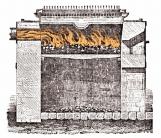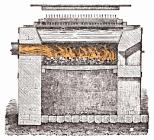14
While still inserted in their wooden frame, the matches are dipped into a chemical paste. The paste is spread in a thin coat over a hot plate heated by a double-boiler to be maintained in a semi-liquid state. The wooden frame containing the sulfur impregnated matches is applied on the plate and each stick is coated with a few millimeters of paste.
15
Step 319th century, circa 1875
Batiscan (Quebec), Canada
 Credits:
Credits:Archives of the Fondation des Amis du Vieux presbytère de Batiscan
16
This chemical paste's composition could vary slightly, but it usually was a combination of phosphorus and another flammable element. Less frequently, a mixture of combustible materials was used without phosphorus. These matches however, could not be ignited by friction. They had to be coupled with a striking strip coated with a thin layer of amorphous phosphorus.
17
Step 419th century, circa 1875
Batiscan (Quebec), Canada
 Credits:
Credits:Archives of the Fondation des Amis du Vieux presbytère de Batiscan
18
Finally, the frames of matches are placed on heated and ventilated racks so that the chemical paste dries. Once dry, the matches are taken off the frames and packed in boxes.
19
FIRE!
On June 13th, 1875, fire broke out in one of the boiler rooms of the church-factory. The blaze rapidly spread to the entire building and the factory was completely destroyed. The losses amounting to $15 000 caused Fréchette to go bankrupt. His properties were handed over to the local authorities so they could be auctioned. The company existing between the parties was dissolved on May 22nd, 1876. That same year, Batiscan lost its residing parish priest. Wenceslas Théophilas Fréchette retired at the Asile Champêtre in Montreal, where he passed away on December 20th, 1888 at the age of 77.